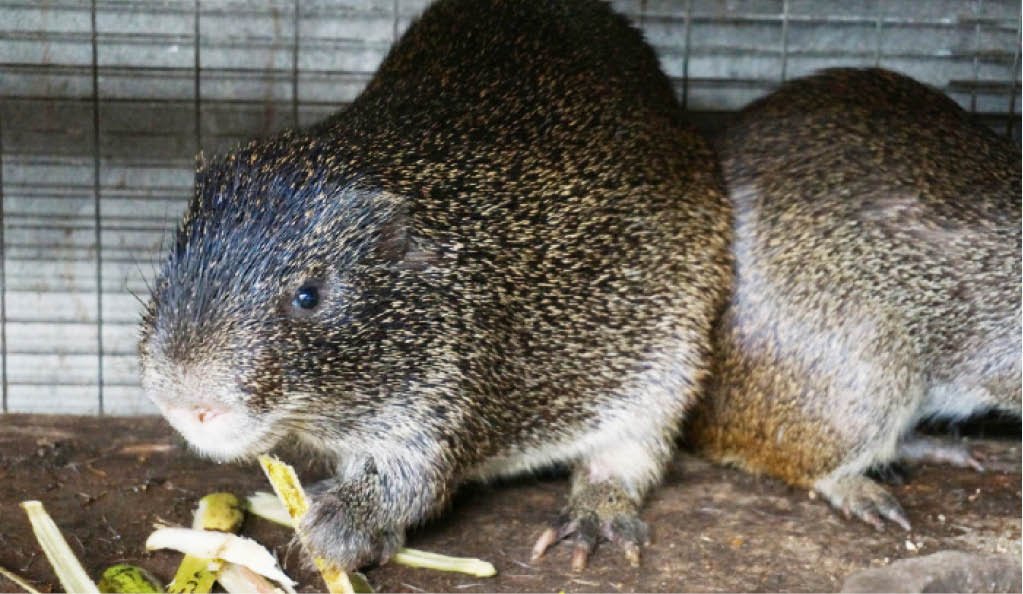Grasscutter Farming in Nigeria
Grasscutters or cane rats are a popular choice for meat in many West African countries, and they are beginning to gain popularity in other parts of the world as well. Grasscutter farming is a very profitable enterprise, and it is not as difficult as you might think to get started.
With growing consumer demand, grasscutter farming presents a lucrative opportunity for farmers and entrepreneurs alike. This section will explore the various factors that contribute to the profitability of this industry in Nigeria.
What are Grasscutters?
Grasscutters (Thryonomys swinderianus), also called Cane Rats and Grass Cutter in English-speaking West African countries, Agouti in French-speaking West African countries and hedgehogs in Central Africa, are rodents that are widely found in wet or grasslands areas in Africa. Though these animals are widely hunted in Africa, they can be domesticated like other micro-livestock animals such as rabbits.
Some characteristics of grasscutters are:
- Grascutters are placid and relatively prolific animal
- They become sexually active and mature at 5-6 months. At this age, they can reproduce and give birth to as high as 12 young.
- They can be easily reared or managed, and this made their domestication an alternative to poaching them in the wild.
- They can grow rapidly in intensive conditions
- The meat of grasscutters is very rich in protein and economically valuable.
Grasscutters are large rodents native to Africa, known for their quick growth rate and high meat yield. They are considered a sustainable and nutritious alternative to traditional livestock like chicken, pork, and beef, making them a valuable source of protein in many African countries.
- Grasscutters are highly adaptable and thrive in various climates, making them suitable for farming in different regions of Nigeria.
- They are herbivores and can be easily fed with readily available and affordable feed sources, further contributing to their cost-effectiveness.
- Grasscutters are relatively low-maintenance animals, requiring minimal infrastructure and specialized skills for their care and management.
- Their meat is highly sought-after for its delicious taste, tender texture, and high nutritional value, boasting a rich source of protein and other essential nutrients.
Grasscutters are large rodents native to Africa, known for their quick growth rate and high meat yield. They are considered a sustainable and nutritious alternative to traditional livestock like chicken, pork, and beef, making them a valuable source of protein in many African countries.

- Grasscutters are highly adaptable and thrive in various climates, making them suitable for farming in different regions of Nigeria.
- They are herbivores and can be easily fed with readily available and affordable feed sources, further contributing to their cost-effectiveness.
- Grasscutters are relatively low-maintenance animals, requiring minimal infrastructure and specialized skills for their care and management.
- Their meat is highly sought-after for its delicious taste, tender texture, and high nutritional value, boasting a rich source of protein and other essential nutrients.
Grasscutters: An Untapped Opportunity in Nigeria
While the potential of grasscutter farming remains largely untapped in Nigeria, it presents a significant opportunity for both individual entrepreneurs and large-scale agricultural ventures. This opportunity arises from a combination of factors, including the high demand for meat, the relatively low cost of production, and the growing interest in sustainable and environmentally friendly food sources.
Grasscutters are highly adaptable and require minimal investment in infrastructure. They can be raised in various settings, including backyard farms, small-scale enclosures, and even integrated farming systems. The meat is considered a delicacy by many Nigerians and has a high market value. This makes grasscutter farming a lucrative option for those seeking to enter the agricultural sector.
Furthermore, grasscutters are considered a more sustainable alternative to traditional livestock like cattle and pigs. They have a lower carbon footprint, require less water, and consume readily available plant materials, reducing dependence on expensive feed sources. This makes grasscutter farming a valuable contributor to sustainable agricultural practices in Nigeria.
Suitable for Grasscutters Farming
Grasscutters, also known as cane rats, thrive in warm, humid climates with abundant vegetation. Nigeria’s tropical climate, characterized by high temperatures and rainfall, provides an ideal environment for their breeding and rearing. The country’s diverse geographical features, including forests, savannas, and wetlands, offer ample natural habitats for these rodents.
Specifically, the southern and Western regions of Nigeria, with their lush vegetation and high rainfall, are particularly well-suited for grasscutter farming. States like Cross, Ondo, River, Akwa Ibom, Delta, and Rivers, boast the most favorable conditions for this type of agriculture. These areas provide a year-round supply of fresh vegetation, which is essential for grasscutters’ diet.
The savanna regions of northern Nigeria also offer opportunities for grasscutter farming, although the climate is drier and the vegetation less abundant. However, careful management of grazing and water sources can ensure successful breeding and rearing.
Grasscutters Farming: A Sustainable Income Source
Grasscutter farming presents a unique opportunity for sustainable income generation in Nigeria, offering a viable alternative to traditional livestock farming. Its numerous advantages make it a promising venture for both small-scale and commercial farmers:
- High Demand: Grasscutters are a highly sought-after delicacy, particularly in urban areas, with a consistent and growing market demand. This ensures a steady source of income for farmers.
- Fast Growth Rate: Compared to other livestock, grasscutters mature quickly, allowing for faster returns on investment. They are also relatively prolific breeders, further boosting profitability.
- Low Input Costs: Grasscutters are herbivores and can thrive on readily available and affordable feed sources like grasses, leaves, and vegetables. This significantly reduces the cost of feed compared to other livestock.
- Resilience and Adaptability: Grasscutters are adaptable to various climates and can be raised in diverse environments, making them suitable for a wide range of regions in Nigeria.
Moreover, grasscutter farming promotes sustainable agricultural practices by utilizing readily available resources and contributing to a more diversified agricultural sector in Nigeria. The farming model also aligns with the growing demand for eco-friendly and sustainable food sources, making it an attractive option for environmentally conscious consumers.
Grasscutters Breeding and Rearing Practices
Breeding Techniques
Grasscutters are prolific breeders, reaching sexual maturity within 3-4 months. They typically give birth to litters of 4-6 pups. Farmers can employ different breeding strategies, including:
- Selective Breeding: Selecting healthy and productive parents for breeding can improve the overall quality of the offspring.
- Crossbreeding: Combining different breeds can enhance disease resistance and growth rate.
Farmers must create a controlled breeding environment to ensure successful reproduction. This involves providing adequate housing, nutrition, and hygiene.
.
Rearing Practices
Rearing grasscutters requires proper management practices for optimal growth and health. These practices include:
- Adequate Housing: Providing spacious and comfortable housing with proper ventilation and hygiene.
- Nutrient-Rich Diet: Feeding a balanced diet that includes fresh grasses, vegetables, fruits, and commercial feeds.
- Disease Prevention: Implementing preventive measures such as regular cleaning, vaccinations, and parasite control.
- Stress Reduction: Maintaining a calm and quiet environment to minimize stress and promote healthy growth.
Farmers should also monitor the growth and development of the grasscutters, separating juveniles from adults to prevent overcrowding and competition for resources.
- Housing: Grasscutters require a secure and comfortable environment. A well-ventilated enclosure with a sturdy floor and walls is essential. The enclosure should be large enough to allow for adequate movement and prevent overcrowding. It can be constructed from concrete, wood, or wire mesh.
- Nesting Boxes: Provide nesting boxes within the enclosure to encourage breeding and promote maternal care. These boxes should be made of sturdy materials and offer a safe and quiet space for grasscutters to rest and raise their young.
- Feeding: A balanced diet is essential for optimal growth and reproduction. Grasscutters are herbivores and their diet should consist of fresh grasses, vegetables, fruits, and commercially available feed.
- Water Availability: Always ensure that fresh water is readily available for grasscutters. Provide a clean water source, such as a water bowl or a drinking nipple, and replenish it regularly.
- Hygiene: Maintaining a clean and hygienic environment is crucial for preventing disease. Regularly clean the enclosure, dispose of waste properly, and disinfect the housing to control the spread of pathogens.
By adhering to these guidelines, you can create a suitable environment for your grasscutters to thrive, ensuring their health, productivity, and overall well-being.




